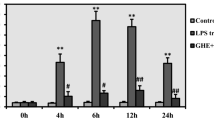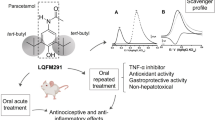Abstract
Plasma concentrations and pharmacokinetics of phenacetin, a CYP1A2 substrate were determined in normal and experimentally induced inflamed rats by turpentine oil to know the role of inflammation on the pharmacokinetics of phenacetin and formation of its active metabolite (paracetamol) by CYP1A2 in wistar albino rats, weighing about 200–250 g that were randomly divided into two groups consisting six in each group. Rats in group I (control) received phenacetin (150 mg kg−1, PO) where as group II received phenacetin 12 h after induction of inflammation by turpentine oil (0.4 mL, i.m). Blood samples were collected from retro orbital plexus at pre-determined time intervals prior to and at 0.166, 0.33, 0.67, 1.5, 2, 4, 8 and 12 h post-administration of phenacetin. Plasma was separated and analyzed for phenacetin and its metabolite paracetamol by HPLC assay. Based on plasma concentrations of phenacetin and its metabolite paracetamol, the pharmacokinetic parameters were determined by compartmental methods. C max of phenacetin was significantly (p < 0.01) decreased to 19.50 ± 2.74 μg mL−1 in inflamed conditions compared to 38.13 ± 2.20 μg mL−1 obtained in normal rats. Except, for significant (p < 0.001) increase in volume of distribution at steady state (V dss) from 2.87 ± 0.37 to 8.03 ± 1.26 L kg−1 and increased the rate of absorption with shorter absorption half-life (t 1/2ka) for phenacetin in inflammation. None of the pharmacokinetic parameters of either phenacetin or its metabolite paracetamol were affected. It can be concluded that turpentine oil induced inflammation has no role on the activity of CYP1A2 in rats, as the plasma concentrations and pharmacokinetic parameters of paracetamol were found unaltered.


Similar content being viewed by others
References
Aguilar-Valles A, Poole S, Mistry Y, Williams S, Luheshi GN (2007) Attenuated fever in rats during late pregnancy is linked to suppressed interleukin-6 production after localized inflammation with turpentine. J Physiol 583:391–403
Andus T, Heinrich PC, Castell JC, Gerok W (1989) Interleukin-6: a key hormone of the acute phase reaction. Dtsch Med Wochenschr 114:1710–1716
Boucher BA, Wood GC, Swanson JM (2006) Pharmacokinetic changes in critical illness. Crit Care Clin 22:255–271
Callaghan JT, Bergstrom RF, Ptak LR, Beasley CM (1999) Olanzapine, pharmacokinetic and pharmacodynamic profile. Clin Pharmacokinet 37:177–193
Chang KC, Bell TD, Lauer BA, Chai H (1978) Altered theophylline pharmacokinetics during acute respiratory viral illness. Lancet 1:1132–1133
Cheng PY, Morgan ET (2001) Hepatic cytochrome P450 regulation in disease states. Curr Drug Metab 2:165–183
de Leon J, Diaz FJ (2003) Serious respiratory infections can increase clozapine levels and contribute to side effects: a case report. Prog Neuropsychopharmacol Biol Psychiatry 27:1059–1063
Eaton DL, Gallagher EP, Bammler TK, Kunze KL (1995) Role of cytochrome P4501A2 in chemical carcinogenesis: implications for human variability in expression and enzyme activity. Pharmacogenetics 5:259–274
el-Sourady HA, Habib FS, Mohamed SI (1985) Availability studies on acetylsalicylic acid, salicylamide and phenacetin at different pH values. Pharmazie 40:639–641
Glen P (2009) An investigation of liver blood flow in systemic inflammation. MD thesis, University of Glasgow
Gotelli GR, Kabra PM, Marton LJ (1977) Determination of acetaminophen and phenacetin in plasma by high-pressure liquid chromatography. Clin Chem 23:957–959
Guengerich F (1993) Cytochrome P450 enzymes. Am Sci 81:440–447
Gutnisky A, Gimeno AL (1987) Intestinal iron absorption during turpentine sterile inflammation in the rat. Influences of isoproterenol and propranolol. Methods Find Exp Clin Pharmacol 9:23–26
Kalitsky-Szirtes J, Shayeganpour A, Brocks DR, Piquette-Miller M (2004) Suppression of drug-metabolizing enzymes and efflux transporters in the intestine of endotoxin-treated rats. Drug Metab Dispos 32:20–27
Lavhekar SS, Lohade AA, Coutinho EC, Iyer KR (2006) Estimation of microsomal CYP1A2 activity by high performance liquid chromatography. Indian J Pharm sci 68:258–261
Maddox JF, Amuzie CJ, Li M, Newport SW, Sparkenbaugh E, Cuff CF, Pestka JJ, Cantor GH, Roth RA, Ganey PE (2009) Bacterial- and viral-induced inflammation increases sensitivity to acetaminophen hepatotoxicity. J Toxicol Env Health A Curr Issues 73:58–73
Monshouwer M, Witkamp RF (2000) Cytochromes and cytokines: changes in drug disposition in animals during an acute phase response: a mini-review. Vet Q 22:17–20
Morrone G, Ciliberto G, Oliviero S, Arcone R, Dente L, Content J, Cortese R (1988) Recombinant interleukin 6 regulates the transcriptional activation of a set of human acute phase genes. J Biol Chem 263:12554–12558
Muraikushiya M, Okada S, Kimura T, Hasegawa R (1993) Effects of turpentine oil pretreatment on beta-blocker pharmacokinetic parameters in rats. J Pharm Pharmacol 45:836–838
Prescott LF (1980) Kinetics and metabolism of paracetamol and phenacetin. Br J Clin Pharmac 10:291S–298S
Renton KW (2001) Alteration of drug biotransformation and elimination during infection and inflammation. Pharmacol Ther 92:147–163
Saeed S, William F, Lise AE, Fakhreddin J (2003) Despite increased plasma concentration, inflammation reduces potency of calcium channel antagonists due to lower binding to the rat heart. Brit J Pharmacol 139:945–954
Sarkar MA, Hunt C, Guzelian PS, Karnes HT (1992) Characterization of human liver cytochromes P-450 involved in Theophylline metabolism. Drug Metab Dispos 20:31–37
Siewert E, Bort R, Kluge R, Heinrich PC, Castell J, Jover R (2000) Hepatic cytochrome P450 down-regulation during aseptic inflammation in the mouse is interleukin 6 dependent. Hepatology 32:49–55
Tous M, Ribas V, Ferre N, Escola-Gil JC, Blanco-Vaca F, Alonso-Villaverde C, Coll B, Camps J, Joven J (2005) Turpentine-induced inflammation reduces the hepatic expression of the multiple drug resistance gene, the plasma cholesterol concentration and the development of atherosclerosis in apolipoprotein E deficient mice. Biochim Biophys Acta 1733:192–198
Whiterock VJ, Morgan DG, Lentz KA, Orcutt TL, Sinz MW (2012) Phenacetin pharmacokinetics in CYP1A2-deficient beagle dogs. Drug Metab Dispos 40:228–231
Xiao Dong S, Zhi Ping Z, Zhong Xiao W, Chong Shu C, Fattore C, Gatti G, D’Urso S, Perucca E (1999) Possible enhancement of the first-pass metabolism of phenacetin by ingestion of grape juice in Chinese subjects. Brit J Clin Pharmacol 48:638–640
Yamaoka K, Nakagawa T (1978) Statistical moments in pharmacokinetics. J Pharmacokinet Biopharm 6:547–557
Yuan R, Madani S, Wei XX, Reynolds K, Huang S-M (2002) Evaluation of cytochrome P450 probe substrates commonly used by the pharmaceutical industry to study in vitro drug interactions. Drug Metab Dispos 30:1311–1319
Zendulka O, Zahradnikova L, Jurica J, Totusek J (2008) The influence of trans-resveratrol and quercetin on the activity of CYP1A2 in rat. Czech J Food Sci 26:S60–S64
Acknowledgments
We specially thank Bristol Myers Squibb India Private Ltd, Bangalore, India for financial support. We also thank the Departments of Veterinary Pharmacology & Toxicology and Veterinary Microbiology of Sri Venkateswara Veterinary University and Department of Zoology, Acharya Nagarjuna University Andhra Pradesh, India for providing the equipment and laboratories used in this investigation.
Conflict of interest
Prasad VGNV: Nil, Vivek Ch: Nil, Anand Kumar P: Nil, Ravi Kumar P: Nil, Rao GS: Nil.
Author information
Authors and Affiliations
Corresponding author
Rights and permissions
About this article
Cite this article
Prasad, V.G.N.V., Vivek, C., Anand Kumar, P. et al. Turpentine oil induced inflammation decreases absorption and increases distribution of phenacetin without altering its elimination process in rats. Eur J Drug Metab Pharmacokinet 40, 23–28 (2015). https://doi.org/10.1007/s13318-013-0172-7
Received:
Accepted:
Published:
Issue Date:
DOI: https://doi.org/10.1007/s13318-013-0172-7




